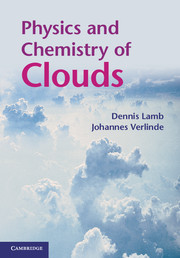Book contents
- Frontmatter
- Contents
- Preface
- Part I Background
- Part II Transformations
- Part III Cloud macrophysics
- Part IV Cloud microphysics
- Part V Cloud-scale and population effects
- 10 Evolution of supersaturation
- 11 Warm clouds
- 12 Cold clouds
- 13 Cloud chemistry
- 14 Cloud electrification
- Appendix A Cloud classification
- Appendix B Overview of thermodynamics
- Appendix C Boltzmann distribution
- References
- Index
14 - Cloud electrification
from Part V - Cloud-scale and population effects
Published online by Cambridge University Press: 07 October 2011
- Frontmatter
- Contents
- Preface
- Part I Background
- Part II Transformations
- Part III Cloud macrophysics
- Part IV Cloud microphysics
- Part V Cloud-scale and population effects
- 10 Evolution of supersaturation
- 11 Warm clouds
- 12 Cold clouds
- 13 Cloud chemistry
- 14 Cloud electrification
- Appendix A Cloud classification
- Appendix B Overview of thermodynamics
- Appendix C Boltzmann distribution
- References
- Index
Summary
Overview
The electrification of large cumulonimbus clouds often leads to lightning, an exciting, yet sometimes frightening phenomenon of nature. The generation of electric fields of sufficient strength to cause electrical breakdown of the air involves a broad range of scales, all the way from the size of individual units of electrical charge (electrons and protons) to that of the cloud itself. Both the microphysical processes and the macroscale motions of air within thunderstorms must act in coordinated ways for charges to separate and large electric fields to develop. The subjects of charging mechanisms, electric-field evolution, and discharge events are each extensive in their own rights. The treatment here offers a basic overview to show the interconnectivity of the various scales and processes.
Electrical structure of thunderstorms and the atmosphere
Thunderstorms, by definition, produce thunder, the audible consequence of lightning. Ever since the pioneering work of Franklin and d'Alibard in the mid-1700s, it has been recognized that lightning is an electrical phenomenon resulting from excess charges in various parts of the parent cloud. Subsequent investigations by Wilson in the 1920s and many others have enabled us to develop a valid conceptual model of thunderstorm electrification.
The simplest charge structure of a thunderstorm is envisioned to be similar to that shown in Fig. 14.1. A convective storm during its mature stage of development exhibits an anvil that represents the upper outflow of cloudy air from the storm's interior.
- Type
- Chapter
- Information
- Physics and Chemistry of Clouds , pp. 529 - 547Publisher: Cambridge University PressPrint publication year: 2011



